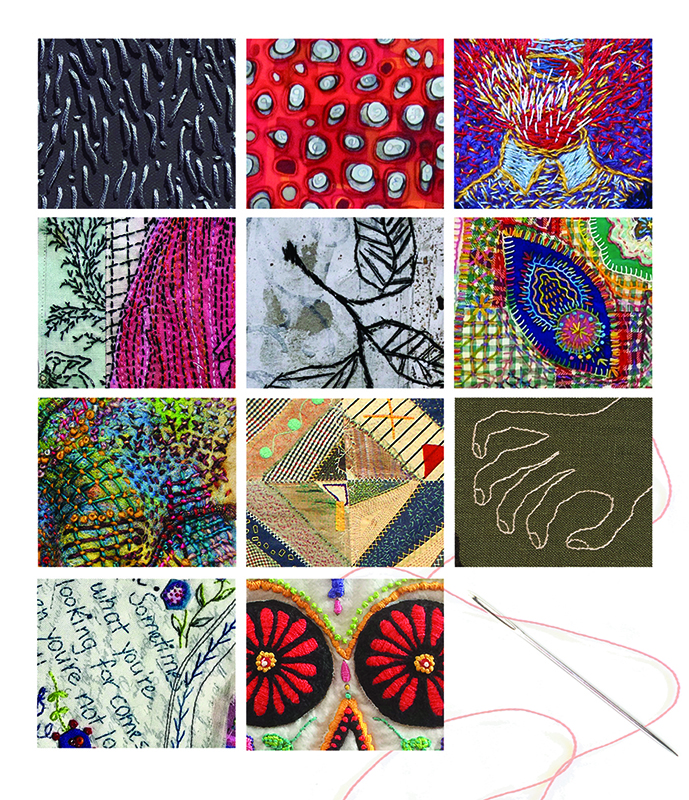June 5 - August 9, 2019
Opening Reception: Wednesday, June 5, 5:00 - 7:00pm
Debbie Armstrong, Beth Cunningham, Jane Dunnewold, Janis Hooker, Lucia LaVilla-Havelin, Barbara Lugge, Kim Paxson, Miki Rodriguez, Mary Ruth Smith, Pamela Studstill, Sue Anne Sullivan
Stitching by hand is a time-consuming meditative journey. The age-old craft of hand embroidery, the simple act of passing a threaded needle through a piece of cloth, continues to be relevant in an era defined by the power of digital technology.
The State of Hand Stitch is a survey of eleven women artists in Texas working with thread and needle at a time when embroidery is increasingly recognized as a medium of choice by serious artists. A hand stitched piece can tell a story, become a vehicle for social comment, or embellish a surface with exuberant color and texture. This exhibit displays a range of subject matter, scale, approach, and materials. Included in museum collections and publications, displayed internationally and recognized for excellence, the work of these artists demonstrates the many possibilities of contemporary stitch.
The work of Beth Cunningham and Mary Ruth Smith is rooted in the experience of sewing clothes, but there the similarity ends. Cunningham is intent on peeling away the public skin provided by clothing to expose what is hidden and unspoken using finely stitched words on linen fabric. Smith stitches over and around fashion illustrations that have been glue-transferred onto a surface of paper and silk organza laminations.
Debbie Armstrong creates large-scale works. One work, Texas Tamale, measures 106 x 80 inches and is a lively composition of densely embroidered Mexican folk images surrounded by more color and more embroidery. Kim Paxson’s small-scale “Little Nasties” is a collection of characters stitched with layers of fine thread and framed in vintage glass measuring, on average, 5-inches, where as her larger work can measure 4-feet or more.
Janis Hooker and Pamela Studstill, each in their own way, have transformed the idea of the embroidery sampler, a traditional piece made by young women to display needlework skills. Hooker starts with a foundation of discarded blankets or scraps, and by adding a layer of complex embroidered stitches, makes a new piece of art. Studstill’s repertoire of perfect stitches is used to create a lively surface “rich with chaos and intricacies of life.”
In contrast, a single stitch is used by Lucia LaVilla-Havelin to infill the simple shapes in her powerful narrative works focused on social issues. Barbara Lugge employs a linear stitch of luminous embroidery floss on painted canvas. On this surface, thread is used to create shadows and a sense of animation.
Sue Anne Sullivan weaves wools, silks and silk fabric strips on a rectangular pin loom, then wet-felts her woven piece causing it to tighten and shrink before embellishing the surface with stitches.
Miki Rodriguez hand stitches linear detail onto her deeply hued abstracts made from layers of discarded materials that may include plastic, price tags or Loteria cards.
Finally, Jane Dunnewold combines surface design techniques with hand stitch. An example is her use of vintage quilt blocks combined with unexpected materials.
Included in museum collections and publication and displayed internationally and recognized for excellence, the work of these select artists comes together in The State of Hand Stitch – an exhibit that offers visual richness, social commentary, and ingenious use of common materials.
"The State of Hand Stitch," by JASMINA WELLINGHOFF, Arts Alive San Antonio
"Exposition Nouvelle Broderie – San Antonio, Texas, USA," by Le Temps de Broder
"A Look at Outsider Art: “The State of Hand Stitch,”" by Linda Simone, Surface Design Association
Free and open to the public. Metered parking is in the Ximenez Avenue Garage
The UTSA Main Art Gallery is located in the Art Building on UTSA’s Main campus on the 2nd floor in room 2.03.04.
Department of Art & Art History
One UTSA Circle San Antonio, TX 78249
ATTN: 2017-19 CONSTRUCTION PARKING MAP
Summer Hours:
Monday - Friday 10am - 4pm
Saturday & Sunday closed
Contact: Victoria.Jones@utsa.edu | 210-458-4391













